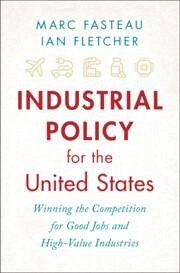- Gebundenes Buch
- Merkliste
- Auf die Merkliste
- Bewerten Bewerten
- Teilen
- Produkt teilen
- Produkterinnerung
- Produkterinnerung
The US can win good jobs and high-value industries with industrial policies that its competitors use now and America used in the past. America should combine tariffs, a competitive dollar, and support for innovation with a new emphasis on manufacturing. This book presents an alternative economics that supports this view.
Andere Kunden interessierten sich auch für
![A History of Central Banking in Great Britain and the United States A History of Central Banking in Great Britain and the United States]() John H. Wood (North Carolina Wake Forest University)A History of Central Banking in Great Britain and the United States52,99 €
John H. Wood (North Carolina Wake Forest University)A History of Central Banking in Great Britain and the United States52,99 €![Prospects for Economic Growth in the United States Prospects for Economic Growth in the United States]() Prospects for Economic Growth in the United States43,99 €
Prospects for Economic Growth in the United States43,99 €![The Cold War and the United States Information Agency The Cold War and the United States Information Agency]() Nicholas J. Cull (University of Southern California)The Cold War and the United States Information Agency163,99 €
Nicholas J. Cull (University of Southern California)The Cold War and the United States Information Agency163,99 €![Understanding the Social Economy of the United States Understanding the Social Economy of the United States]() Laurie MookUnderstanding the Social Economy of the United States57,99 €
Laurie MookUnderstanding the Social Economy of the United States57,99 €![The Economics of Platforms The Economics of Platforms]() Paul Belleflamme (Belgium Universite Catholique de Louvain)The Economics of Platforms27,99 €
Paul Belleflamme (Belgium Universite Catholique de Louvain)The Economics of Platforms27,99 €![A Concise History of the United States of America A Concise History of the United States of America]() Susan-Mary Grant (University of Newcastle upon Tyne)A Concise History of the United States of America37,99 €
Susan-Mary Grant (University of Newcastle upon Tyne)A Concise History of the United States of America37,99 €![The Cambridge Handbook of Policing in the United States The Cambridge Handbook of Policing in the United States]() The Cambridge Handbook of Policing in the United States38,99 €
The Cambridge Handbook of Policing in the United States38,99 €-
-
-
The US can win good jobs and high-value industries with industrial policies that its competitors use now and America used in the past. America should combine tariffs, a competitive dollar, and support for innovation with a new emphasis on manufacturing. This book presents an alternative economics that supports this view.
Produktdetails
- Produktdetails
- Verlag: Cambridge University Press
- Seitenzahl: 838
- Erscheinungstermin: 21. November 2024
- Englisch
- Abmessung: 235mm x 157mm x 49mm
- Gewicht: 1314g
- ISBN-13: 9781009243070
- ISBN-10: 1009243071
- Artikelnr.: 70387606
- Herstellerkennzeichnung
- Libri GmbH
- Europaallee 1
- 36244 Bad Hersfeld
- gpsr@libri.de
- Verlag: Cambridge University Press
- Seitenzahl: 838
- Erscheinungstermin: 21. November 2024
- Englisch
- Abmessung: 235mm x 157mm x 49mm
- Gewicht: 1314g
- ISBN-13: 9781009243070
- ISBN-10: 1009243071
- Artikelnr.: 70387606
- Herstellerkennzeichnung
- Libri GmbH
- Europaallee 1
- 36244 Bad Hersfeld
- gpsr@libri.de
Marc Fasteau is a vice-chair of the Coalition for a Prosperous America. Before founding an insurance company acquired by Progressive, he was a partner at Dillon Read & Co., a New York investment bank. Earlier in his career he served on the professional staffs of the US Senate majority leader, the Joint Economic Committee and the House Banking and Currency Committee. He is a graduate of Harvard College and Harvard Law School, where he was on the Harvard Law Review.
Preface
Introduction
Part I. The Underlying Economics: 1. Why the free market can't do everything
2. The dynamics of advantageous industries
3. The Industrial Policy Tool Kit
4. Trade, currencies & industrial policy
Part II. Country Case Studies: 5. Japan: the first Asian miracle
6. Korea: development despite turbulence
7. China: pursuing economic hegemony through mercantilism
8. Germany: the art of relationship capitalism
9. France: the triumph & failures of the state
10. Britain: no theory & little execution
11. India: dysfunctional socialism, directionless capitalism
12. Argentina: a dual cautionary tale
Part III. The Forgotten History: 13. The renaissance origins of industrial policy
14. US industrial policy 1750-1865: developing a new nation
15. US industrial policy 1866-1939: the highpoint of protectionism
16. US industrial policy 1940-1973: the golden age of the us economy
17. US industrial policy 1974-2007: doubling down on free markets
18. US industrial policy 2008-present: the end of the old order
Part IV. Innovation as A System: 19. Governmentally supported innovations
20. Federal science & technology programs
21. Federal proactive innovation programs
22. Industrial policy for advanced manufacturing
23. Micro-governance of industrial policy
24. The crisis of the American patent system
Part V. Industry Case Studies: 25. Automobiles: decline & a chance at revival
26. Semiconductors, aviation & space: the military connection
27. Robotics: a global industrial policy competition
28. Nanotechnology: is America losing the future?
Part VI. Regional Cluster Case Studies: 29. The Massachusetts life sciences cluster
30. The upstate New York semiconductor cluster
Recommendations: an industrial policy for the United States
Notes
Select bibliography
Index.
Introduction
Part I. The Underlying Economics: 1. Why the free market can't do everything
2. The dynamics of advantageous industries
3. The Industrial Policy Tool Kit
4. Trade, currencies & industrial policy
Part II. Country Case Studies: 5. Japan: the first Asian miracle
6. Korea: development despite turbulence
7. China: pursuing economic hegemony through mercantilism
8. Germany: the art of relationship capitalism
9. France: the triumph & failures of the state
10. Britain: no theory & little execution
11. India: dysfunctional socialism, directionless capitalism
12. Argentina: a dual cautionary tale
Part III. The Forgotten History: 13. The renaissance origins of industrial policy
14. US industrial policy 1750-1865: developing a new nation
15. US industrial policy 1866-1939: the highpoint of protectionism
16. US industrial policy 1940-1973: the golden age of the us economy
17. US industrial policy 1974-2007: doubling down on free markets
18. US industrial policy 2008-present: the end of the old order
Part IV. Innovation as A System: 19. Governmentally supported innovations
20. Federal science & technology programs
21. Federal proactive innovation programs
22. Industrial policy for advanced manufacturing
23. Micro-governance of industrial policy
24. The crisis of the American patent system
Part V. Industry Case Studies: 25. Automobiles: decline & a chance at revival
26. Semiconductors, aviation & space: the military connection
27. Robotics: a global industrial policy competition
28. Nanotechnology: is America losing the future?
Part VI. Regional Cluster Case Studies: 29. The Massachusetts life sciences cluster
30. The upstate New York semiconductor cluster
Recommendations: an industrial policy for the United States
Notes
Select bibliography
Index.
Preface
Introduction
Part I. The Underlying Economics: 1. Why the free market can't do everything
2. The dynamics of advantageous industries
3. The Industrial Policy Tool Kit
4. Trade, currencies & industrial policy
Part II. Country Case Studies: 5. Japan: the first Asian miracle
6. Korea: development despite turbulence
7. China: pursuing economic hegemony through mercantilism
8. Germany: the art of relationship capitalism
9. France: the triumph & failures of the state
10. Britain: no theory & little execution
11. India: dysfunctional socialism, directionless capitalism
12. Argentina: a dual cautionary tale
Part III. The Forgotten History: 13. The renaissance origins of industrial policy
14. US industrial policy 1750-1865: developing a new nation
15. US industrial policy 1866-1939: the highpoint of protectionism
16. US industrial policy 1940-1973: the golden age of the us economy
17. US industrial policy 1974-2007: doubling down on free markets
18. US industrial policy 2008-present: the end of the old order
Part IV. Innovation as A System: 19. Governmentally supported innovations
20. Federal science & technology programs
21. Federal proactive innovation programs
22. Industrial policy for advanced manufacturing
23. Micro-governance of industrial policy
24. The crisis of the American patent system
Part V. Industry Case Studies: 25. Automobiles: decline & a chance at revival
26. Semiconductors, aviation & space: the military connection
27. Robotics: a global industrial policy competition
28. Nanotechnology: is America losing the future?
Part VI. Regional Cluster Case Studies: 29. The Massachusetts life sciences cluster
30. The upstate New York semiconductor cluster
Recommendations: an industrial policy for the United States
Notes
Select bibliography
Index.
Introduction
Part I. The Underlying Economics: 1. Why the free market can't do everything
2. The dynamics of advantageous industries
3. The Industrial Policy Tool Kit
4. Trade, currencies & industrial policy
Part II. Country Case Studies: 5. Japan: the first Asian miracle
6. Korea: development despite turbulence
7. China: pursuing economic hegemony through mercantilism
8. Germany: the art of relationship capitalism
9. France: the triumph & failures of the state
10. Britain: no theory & little execution
11. India: dysfunctional socialism, directionless capitalism
12. Argentina: a dual cautionary tale
Part III. The Forgotten History: 13. The renaissance origins of industrial policy
14. US industrial policy 1750-1865: developing a new nation
15. US industrial policy 1866-1939: the highpoint of protectionism
16. US industrial policy 1940-1973: the golden age of the us economy
17. US industrial policy 1974-2007: doubling down on free markets
18. US industrial policy 2008-present: the end of the old order
Part IV. Innovation as A System: 19. Governmentally supported innovations
20. Federal science & technology programs
21. Federal proactive innovation programs
22. Industrial policy for advanced manufacturing
23. Micro-governance of industrial policy
24. The crisis of the American patent system
Part V. Industry Case Studies: 25. Automobiles: decline & a chance at revival
26. Semiconductors, aviation & space: the military connection
27. Robotics: a global industrial policy competition
28. Nanotechnology: is America losing the future?
Part VI. Regional Cluster Case Studies: 29. The Massachusetts life sciences cluster
30. The upstate New York semiconductor cluster
Recommendations: an industrial policy for the United States
Notes
Select bibliography
Index.








